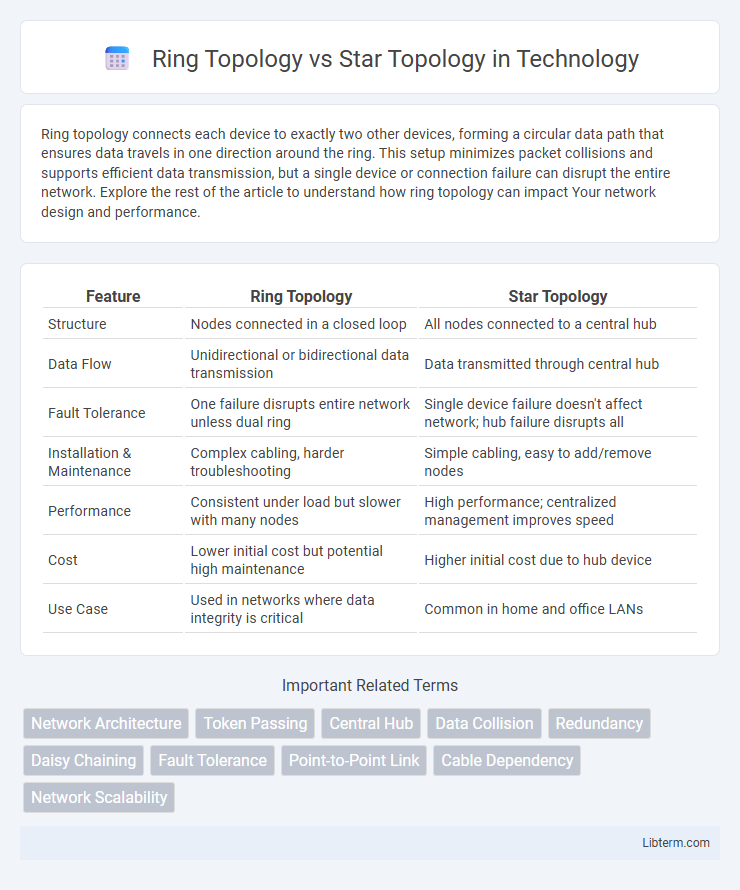Ring topology connects each device to exactly two other devices, forming a circular data path that ensures data travels in one direction around the ring. This setup minimizes packet collisions and supports efficient data transmission, but a single device or connection failure can disrupt the entire network. Explore the rest of the article to understand how ring topology can impact Your network design and performance.
Table of Comparison
| Feature | Ring Topology | Star Topology |
|---|---|---|
| Structure | Nodes connected in a closed loop | All nodes connected to a central hub |
| Data Flow | Unidirectional or bidirectional data transmission | Data transmitted through central hub |
| Fault Tolerance | One failure disrupts entire network unless dual ring | Single device failure doesn't affect network; hub failure disrupts all |
| Installation & Maintenance | Complex cabling, harder troubleshooting | Simple cabling, easy to add/remove nodes |
| Performance | Consistent under load but slower with many nodes | High performance; centralized management improves speed |
| Cost | Lower initial cost but potential high maintenance | Higher initial cost due to hub device |
| Use Case | Used in networks where data integrity is critical | Common in home and office LANs |
Introduction to Network Topologies
Network topologies define the physical or logical arrangement of devices in a network, with ring and star topologies being two foundational structures. Ring topology connects each device to exactly two others, forming a circular data path that enables data to travel in one or both directions, enhancing fault tolerance and data integrity. Star topology features a central hub or switch connecting all devices, offering simplified troubleshooting, scalable network expansion, and centralized management, which makes it widely adopted in modern Ethernet networks.
Overview of Ring Topology
Ring topology connects each device to exactly two other devices, forming a circular data path for signal transmission. Data travels in one direction around the ring, with each device acting as a repeater to boost signal strength and maintain communication integrity. This topology minimizes cable length compared to star topology but can be vulnerable to a single point of failure if one device or connection breaks.
Overview of Star Topology
Star topology features a central hub or switch to which all network devices connect directly, ensuring efficient data transmission and easy network management. This design isolates each device, minimizing the impact of individual node failures on the overall network performance. Star topology's scalability and straightforward troubleshooting make it a preferred choice for many modern LAN implementations.
Key Components of Ring and Star Topologies
Ring topology key components include network nodes connected in a closed loop, with data packets circulating in one direction through each node's repeater or transceiver. Star topology consists of central hub or switch to which all nodes connect independently, allowing direct communication and centralized management. The ring relies on token-passing protocols for data transmission, while the star's hub governs data traffic and fault isolation.
Data Transmission in Ring vs Star Topologies
Data transmission in ring topology occurs sequentially, with each device passing data along the ring until it reaches the destination, ensuring equal access but potentially causing delays if one node fails. In contrast, star topology transmits data through a central hub or switch, allowing simultaneous communication between devices and faster data transfer speeds due to dedicated links. Star topology offers better fault tolerance by isolating device failures from the network, whereas ring topology relies on token passing, which can affect data flow efficiency.
Advantages of Ring Topology
Ring topology offers efficient data transmission with equal access for all devices, reducing the chances of data collision compared to star topology. Its unidirectional or bidirectional data flow simplifies fault isolation, which enhances network reliability and maintenance. The topology supports high-speed performance in smaller networks by minimizing the need for central devices, lowering infrastructure costs.
Advantages of Star Topology
Star topology offers centralized network management, making troubleshooting and fault isolation straightforward by connecting each device directly to a central hub or switch. This design enhances network reliability since failure in one cable or device does not affect the entire network, minimizing downtime. Scalability is improved as new devices can be easily added or removed without disrupting overall network performance.
Disadvantages of Ring Topology
Ring topology suffers from extensive downtime when a single node or connection fails, as data transmission is interrupted until the fault is resolved. Scalability issues arise because adding or removing devices requires the network to be temporarily shut down, affecting overall network availability. The complexity of troubleshooting faults increases with the number of nodes, making maintenance more time-consuming compared to star topology.
Disadvantages of Star Topology
Star topology's main disadvantage lies in its reliance on a central hub or switch, making the entire network vulnerable to a single point of failure that can disrupt communication across all connected devices. Scalability issues arise as the cost and complexity increase with the number of nodes due to cabling requirements and hardware limitations. Troubleshooting can be straightforward but the hub's failure demands immediate attention to restore network functionality, making it a critical vulnerability compared to Ring topology's distributed data path.
Ring vs Star Topology: Use Cases and Best Practices
Ring topology excels in environments requiring predictable data transmission and fault isolation, such as metropolitan area networks (MANs) and fiber distributed data interface (FDDI) systems. Star topology dominates in local area networks (LANs) due to its simplicity, scalability, and ease of troubleshooting, making it ideal for office networks and home setups. Best practices recommend ring topology for applications demanding high reliability and data integrity, while star topology suits dynamic network expansions and centralized management.
Ring Topology Infographic

 libterm.com
libterm.com